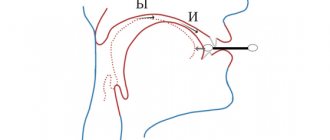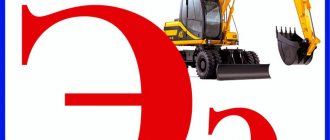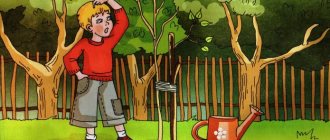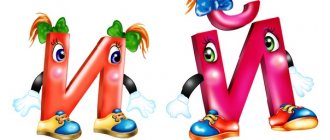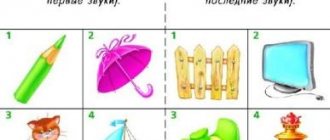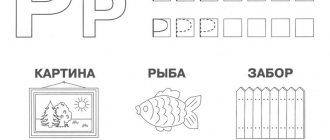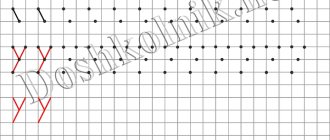Summary of a lesson on teaching literacy to older preschoolers “Sound [a] and letter A”
Lesson notes
“The sound [a] and the letter A”
for older children
Target:
introduce children to the letter A, which denotes the vowel sound [a];
characterize the sound, consolidate the correct pronunciation of the sound a
Tasks:
clarify the pronunciation of the sound [a];
teach children to distinguish the sound [a] from a number of other vowel sounds;
develop phonemic hearing and phonemic perception;
Progress of the lesson
Educator:
Guys, today the doll Anya came to visit us. She has prepared an interesting task for you. Look at the pictures and name them. (Children's answers).
Tell me what is the first sound we hear in all these words.
- That's right, the sound [a] is heard.
Children: They all start with the sound [A]
Educator: Let's all pronounce the sound [A] together (the teacher puts up a picture of the sound being pronounced) with the mouth open wide.
This sound is sung, and when we pronounce it in our mouth, we don’t feel any obstruction, which means it’s a vowel - repeat. We denote vowel sounds in red (red circle). The sound [A] is indicated by the letter A. (The letter A is set).
Development of articulatory motor skills.
- And to make it easier for us to speak, let's stretch our tongue and lips.
- lip exercises: smile – fence – proboscis
- exercises for the tongue: “delicious jam”, “watch”, “swing”.
- Now let's play. Let's pronounce the sound [a] silently, just with our lips - in a whisper - quietly - loudly. For this, the Anya doll prepared magic circles. If it shows a red circle, then you will pronounce the sound [a] loudly, blue - quietly, green - in a whisper, and if white - silently.
And the sound can be pronounced for a long time, aaaaaaaaaaaaaaa (the teacher pronounces the sound and moves the pointer along the path and pronounces the sound for a long time), or it can be pronounced briefly. A. (the teacher pronounces the sound and moves the pointer along the path and pronounces the sound briefly).
Game “Find out by sound”
.
- Now get your palms ready. You need to clap your hands when you hear the sound [A]. Be careful, let's start the game:
- A, U, I, M, O, A, S, E
- SA, KU, PY, SO, DI; AS, OS, UM, US, AP
- garden, tree, crayfish, juice, tap, braid, meat, candy.
Physical education minute
Hands up and into a fist,
Hands down and on your side
We'll sit down and say wow
We'll stand up and say, ah-ah-ah
It's time for us to get down to business. (repeat 2 times).
Educator:
Guys, I already said that the sound [A] is indicated by the letter A. (show the letter A)
Save it!!! We hear and pronounce the sound, and we see and write the letter.
Look how I write it. (The teacher writes a letter on the board) and says: shelf, stick and line - the result is the letter A.
Work in notebooks.
We write the printed letter A, and draw a circle next to it with a red felt-tip pen.
Summary of a literacy lesson in the senior group
Summary of a literacy lesson in the senior group “Introduction to the sound “A” and the letter “A”
(First year of study)
Program content:
1.
Develop the skill of clearly pronouncing the sound “a”.
2.
Learn to isolate sounds from a series of vowels.
3.
Develop auditory attention.
4.
Introduce the letter "A".
5.
Develop fine motor skills.
Materials:
Doll, plot picture “Girl rocking a doll”, symbol (card) of the sound “A”, red circle, card with the letter “A”
(from the alphabet), sticks, workbook, colored pens.
I. Organizational moment
- The one who names the sign of autumn will sit down.
1.
Finger gymnastics “Autumn leaves scattered”:
Autumn scattered leaves, wave-like movements with palms.
I decorated them with a brush . Smooth strokes of the palms up and down.
We will go to the autumn park, “Walking” with the fingers of both hands.
We will collect leaves into bouquets. Cross your palms with your fingers spread out.
A maple leaf, a leaf from an aspen tree, Bend your fingers one by one, starting with
Oak leaf, rowan leaf, large, on both hands at the same time
A red poplar leaf for each leaf.
He jumped down onto the path. They clap their hands loudly.
2.
- Guys, we have a doll visiting us today. Her name is Ann. She has prepared a task for you.
Listen and name the first sound in the words:
arch, antenna, watermelon, acrobat.
- That's right, the sound “A” is heard. This is a vowel sound, it is sung and we don’t feel any obstacle in our mouth when we pronounce it. Look at the picture: a girl rocks a doll and sings “AAAA” to it.
II. Main part.
3.
Articulation of sound.
- Let's make a sound
"A".
Open your mouth wide
We gently rock the doll. (Pronounced individually and in chorus, with different voice strengths - quieter, louder.)
4.
– Look at the pictures carefully and name them.
(Work in Konovalenko’s notebook).
— Circle the pictures whose names begin with the sound “A”.
- Well done, the names of these pictures begin with the sound “A”.
5.
- The task was completed. Now look, I have a red circle in my hands - this is a symbol of the sound “A”. This is how we will designate it.
6. Game “Clap your hands when you hear the sound “A”:
a, y, o, a, s, i, a, e, y, a.
6.
Introducing the letter "A".
— Listen to the poem:
The letter A is tall and slender.
It looks very much like an arch.
- Look at the letter “A”. (A card with the image of the letter “A” is displayed).
- Find the letter “A” in your notebook, in the upper right corner. Run your finger over it (circle) and color it with a red pencil. Why red, who can tell me?
- Because the sound “A” is a vowel and we denote it in red.
7.
“You’ve worked hard and your fingers are tired, let’s stretch them.”
Finger gymnastics “We shared an orange.”
— See how you can form the letter “A” from your fingers:
The index and middle fingers of the right hand are lowered down, the remaining fingers are clenched into a fist, and the index finger of the left hand forms a crossbar.
Let's try to put it together.
8.
Laying out the letter “A” from sticks, drawing in the air.
9.
Print the letter "A" in your notebooks.
Sh.
Summary of the lesson, assessment of children.
- Guys, remember what sound we met in class today?
- With what letter?
- What color do we use?
— What did you like most?
- Well done, they studied well, listened carefully, answered questions.
Summary of the lesson “Sound and letter A”. Lesson on generalization and systematization of knowledge
Topic: sound and letter A.
Lesson type: lesson of generalization and systematization of knowledge.
Goal: to systematize students’ knowledge about the vowel sound and the letter A.
Educational: - Continue to teach how to isolate the vowel sound [A] and designate it with a letter.
Corrective and developmental: - Form finger and articulatory motor skills - Develop phonemic perception and representation. — Form sound-syllable analysis and synthesis. — Continue to work on developing kinesthetic sensations. — Correct thinking based on practicing the operation of analysis and synthesis. — Develop the perception of shape by working with geometric shapes. — Use health-saving actions to maintain performance and expand the functional capabilities of the students’ body (dance of vowels, physical exercises, alternation of various types of activities). — Correct attention based on the formation of the ability to distribute.
Correctional and educational: - To develop the ability to understand and accept an educational task posed in verbal form; — Continue to learn how to answer questions during the course of study with adequate use of the learned terminology. — Develop the ability to actively comprehend the material covered.
Equipment: Demonstration material: PC, PP presentation. Handouts: Mirrors, match sticks, homework cards.
Progress of the lesson:
1. Organizational moment The one who recognizes the geometric shapes will sit down.
2. Articulation gymnastics Let's prepare our tongues for work.
3. Finger gymnastics Work with sticks. Laying out figures according to the pattern. Clarification of the name.
4. Work in a notebook in a square Sketching an oval. Hatching the oval from left to right.
5. Repetition of what has been covered Vowel sounds - they sing, dance, do not meet obstacles. Those who agree stumble upon everything, they stumble over everything. Consonants encounter obstacles in the form of lips, teeth, and tongue.
6. Guessing the topic of the lesson. Pronunciation. Proof. Dance. Sound dance: the child stands, holds his hands in front of him in the shape of a wide oval.
7. Working with the articulatory profile Determining the position of the lips, teeth, tongue, and the functioning of the vocal cords when pronouncing a sound. Conclusion: The sound is a vowel.
8. Work with signal cards and in notebooks. Search for the sound [A] in words. If there is [A] in the word - a card with a + sign, if not - with a sign - Orally: army, cat, fish, shower, mushroom, bull, March. In writing: table, sled, hole, scales, smoke, roof, hand.
9. Listening to an audio recording about the sound and letter A. Recording the topic of the lesson.
10. Aunt Owl’s story about the letter A Finding out which words you remember. Clarification of the lexical meaning of these words.
11. Reading forward and backward syllables (choral, in turn) Writing any two syllables in a notebook. We write down the letters of vowel sounds with a pen with red ink.
12. Phys. pause o/r Hammer-hamster hamster (make movements according to the text) Striped flank. The hamster gets up early, washes his cheeks, rubs his neck. Khomka sweeps the hut and goes out to exercise. One, two, three, four, five, Khomka wants to become strong.
13. Working with pictures from the monitor screen. (At the board and in the notebook). Recognition of objects. Recording the names of objects with pronunciation on the board and in a notebook. The letters of vowel sounds are in red. Division into syllables. Repetition of the rule: the number of vowels in a word, the number of syllables.
14. Lesson summary
Presentation for the lesson notes “Sound and letter A”
| The presentation on slide 20 has a link to the video below. You can download the original presentation file. |
Video for lesson notes “Sound and letter A”
Also on topic:
logoped18.ru
Summary of educational activities for teaching literacy in the senior group.
Author: Yatsenko Vera Borisovna
teacher of the preschool educational institution "Kindergarten No. 157", Magnitogorsk
Summary of educational activities for teaching literacy in the senior group.
Summary of educational activities for teaching literacy (senior group)
Topic: Sounds “G-K”, “K-K”. Letters "G", "K". Reading syllables, composing and writing sentences.
Target:
Contribute to the development of sound-letter analysis. Introduce the sounds “G-K” as voiced and voiceless consonants. Introduce the sounds “Г-Гь”, “К-Кь”. Strengthen the ability to use symbols of consonant and vowel sounds: blue square - hard sounds, green square - soft sounds, red square - vowel sounds. Develop the ability to listen carefully to the text of a poem, select words that are not only close in sound, but also suitable in meaning. Introduce the letters “G”, “K” as written signs of consonant sounds. Develop the skill of writing the printed letters “G”, “K”, first using dots, then independently. Introduce how to read syllables with “G” + 10 vowels, with “K” + 10 vowels. Continue to help children master composing three-word sentences based on a story picture. Develop the ability to write a sentence using symbols. Develop the ability to understand a learning task and complete it independently. Develop the skills of self-control and self-esteem.
Material and equipment:
Musical instruments: drum and bell.
Progress:
- Comparison of drum and bell sounds
. (voiced - voiceless).
With fingers, palms, elbows, mallets, people hit and try to hit the top of his head. I can only tell you one thing - this is a well-known musical instrument
(drum)
He sits under his cap, don’t disturb him - he’s silent. All you have to do is take him in your hands and rock him a little, and you can hear the chime: “Dili-don, dili-don. "(Bell)
I invite the children to listen to the sounds of a bell and a drum.
The drum has a dull sound, but the bell has a ringing sound.
- Game "Give me a word."
Name the first sound in the given words.
I respect water very much in any bad weather.
I keep away from dirt the clean gray...(goose).
I didn’t tremble before the wolf, I ran away from the bear,
But the fox still got a bite... (gingerbread man).
Conduct a comparative analysis of the sounds “G” and “K”.
- Game "Word, scheme".
Name the picture whose title contains the first sound “K”. (Cat)
Name the picture whose title contains the first sound “Кь”. (Whale)
Are the first sounds in these words pronounced the same way? (No, in the word CAT - K, KIT - Kb)
Color the square under the picture with the appropriate color.
Name the picture whose title contains the first sound “G”. (Peas)
Name the picture whose title contains the first sound “Гь”. (Weight)
Are the first sounds in these words pronounced the same way? (no, in the word peas there is a G sound, and in
word kettlebell Gb).
What color did you paint the square under the picture of peas? (Blue,
because the G sound sounds hard).
What color did you paint the square under the picture showing the weight? (Green,
because the sound Гь sounds soft).
- Fizminutka:
—
Are you tired?
- What are you, what are you no, no, no.
Game “Name it kindly” with a ball
(nose - spout, mouth, eye, forehead, elbow, finger, belly, nail, hair). What sound is heard at the end of a kind word? (TO)
- Game exercise “Syllabic houses”.
The letters G and K are written in the left corner, and their comic image is in the right corner.
The letter G is completely different: it is slender, straight,
Keep your nose ahead so you know where to go.
Write the letter G in syllabic houses, first using dots, then independently. Read the syllables in the syllable houses.
I can tell you with confidence about the letter K - a butterfly sat on the wall.
Write the letter K in syllabic houses, first using dots, then independently. Read the syllables in the syllable houses.
In what cases are consonants pronounced as hard, and in what cases are they pronounced as soft?
(If the vowels A, O, U, Y, E are written after them, then they are pronounced as hard consonants; if the vowels are I, Yu, E, Yo, I, then they are pronounced as soft consonants). Come up with a pure saying with the syllable GA, KU.
- Compose and write a sentence in symbols.
Make up a sentence based on the picture using three words.
Write it down in the form of a diagram (Three rectangles -
Name the first word in the sentence. Second. Third).
Guys, what sounds did we meet today?
G – voiced, K – voiceless.
- Game “Come up with a word starting with “G” and “K”.
Let's have a competition.
Whoever comes up with more ideas will get more chips.
Guys, evaluate your work in class.
Lesson: Getting to know the sound [A] and the letter [A]
Content
01 Feb 2011 Author Ekaterina
Summary of a literacy lesson in the senior group “Introduction to the sound “A” and the letter “A”
(First year of study)
Program content:
1. Develop the skill of clearly pronouncing the sound “a”.
2. Learn to isolate sounds from a series of vowels.
3. Develop auditory attention.
4. Introduce the letter "A".
5. Develop fine motor skills.
Materials:
Doll, plot picture “Girl rocking a doll”, symbol (card) of the sound “A”, red circle, card with the letter “A”
(from the alphabet), sticks, workbook, colored pens.
I. _ Organizing time
- The one who names the sign of autumn will sit down.
1. Finger gymnastics “Autumn leaves scattered”:
Autumn scattered leaves, wave-like movements with palms.
I decorated them with a brush. Smooth strokes of the palms up and down.
We will go to the autumn park, “Walking” with the fingers of both hands.
We will collect leaves into bouquets. Cross your palms with your fingers spread out.
A maple leaf, a leaf from an aspen tree, Bend your fingers one by one, starting with
Oak leaf, rowan leaf, large, on both hands at the same time
A red poplar leaf for each leaf.
He jumped down onto the path. They clap their hands loudly.
2. - Guys, we have a doll visiting us today. Her name is Ann. She has prepared a task for you.
Listen and name the first sound in the words:
arch, antenna, watermelon, acrobat.
- That's right, the sound “A” is heard.
This is a vowel sound, it is sung and we don’t feel any obstacle in our mouth when we pronounce it. Look at the picture: a girl rocks a doll and sings “AAAA” to it. II .
Main part. 3. Articulation of sound.
- Let's pronounce the sound “A” together.
Open your mouth wide
We gently rock the doll. (Pronounced individually and in chorus, with different voice strengths - quieter, louder.)
4. – Look at the pictures carefully and name them.
(Work in Konovalenko’s notebook).
– Circle the pictures whose names begin with the sound “A”.
- Well done, the names of these pictures begin with the sound “A”.
5. - The task was completed. Now look, I have a red circle in my hands - this is a symbol of the sound “A”. This is how we will designate it.
6. Game “Clap your hands when you hear the sound “A”:
a, y, o, a, s, i, a, e, y, a.
6. Introducing the letter "A".
– Listen to the poem:
The letter A is tall and slender.
It looks very much like an arch.
- Look at the letter “A”. (A card with the image of the letter “A” is displayed).
– Find the letter “A” in your notebook, in the upper right corner. Run your finger over it (circle) and color it with a red pencil. Why red, who can tell me?
– Because the sound “A” is a vowel and we denote it in red.
7. “You’ve worked hard and your fingers are tired, let’s stretch them.”
Finger gymnastics “We shared an orange.”
– See how you can form the letter “A” from your fingers:
The index and middle fingers of the right hand are lowered down, the remaining fingers are clenched into a fist, and the index finger of the left hand forms a crossbar.
Let's try to put it together.
8. Laying out the letter “A” from sticks, drawing in the air.
9. Print the letter "A" in your notebooks.
Sh. Summary of the lesson, assessment of children.
- Guys, remember what sound we met in class today?
- With what letter?
– What color do we use?
– What did you like most?
- Well done, they studied well, listened carefully, answered questions.
Speech therapy for everyone
I recommend reading:
The author is pleased, it’s not difficult for you - click “I LIKE”
Author: Ekaterina
Hello! My name is Ekaterina and I am glad to welcome you to the website “ Speech Therapy for Everyone .” If you liked the materials on the site, then you can subscribe to new publications via RSS or Email. Also join our speech therapy group on Facebook and VKontakte .
The author has published 485 articles.
Previous material from the section - Notes of speech therapy classes:
www.logolife.ru
